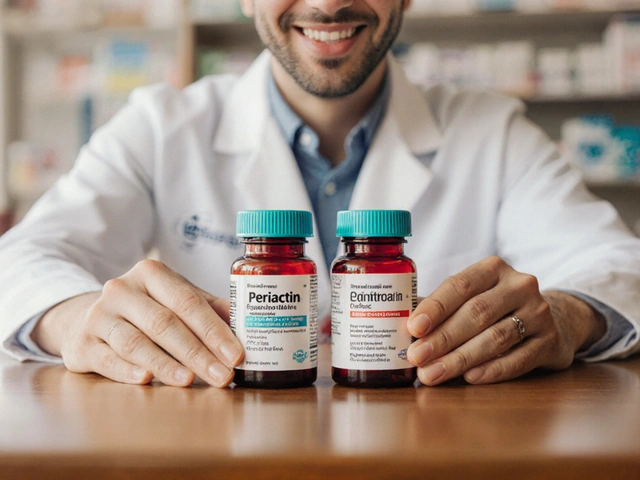Pain Medication Decision Tool
Personalized Pain Medication Recommendation
This tool helps you understand which pain medications might be most appropriate for your situation based on pain intensity, duration, and health conditions. Always consult with your healthcare provider before making any medication decisions.
When you need fast, strong pain relief after surgery or a severe injury, doctors often turn to Ketorolac is a prescription non‑steroidal anti‑inflammatory drug (NSAID) sold under the brand name Toradol. It works by blocking cyclooxygenase enzymes to reduce prostaglandin production, delivering powerful short‑term pain relief. But is it the best choice for you? Let’s compare it side‑by‑side with the most popular alternatives and see where it shines, where it falls short, and how to decide what fits your situation.
How Ketorolac Works - The Science in Plain English
Ketorolac belongs to the NSAIDs class of drugs, which means it inhibits both COX‑1 and COX‑2 enzymes. By doing so, it cuts the cascade that creates prostaglandins, the chemicals that cause pain, fever, and inflammation. The result is a rapid drop in pain signals, usually within 30 minutes when given intravenously and about an hour when taken orally.
When Doctors Choose Ketorolac - Typical Use Cases
Because it’s very effective, Ketorolac is usually reserved for short‑term use (no more than five days) after major surgery, dental extractions, kidney stones, or severe musculoskeletal injuries. Its potency rivals that of many opioids, yet it doesn’t produce the same risk of dependence. That makes it attractive for patients who need strong relief but want to avoid opioid‑related side effects.
Major Alternatives - A Quick Overview
Below is a snapshot of the most common alternatives you’ll hear about:
- Ibuprofen - an over‑the‑counter NSAID used for mild to moderate pain and inflammation.
- Naproxen - another OTC NSAID with a longer half‑life, often chosen for chronic conditions like arthritis.
- Diclofenac - a prescription NSAID that can be taken orally or applied topically.
- Acetaminophen (known as paracetamol in the UK) - not an NSAID, but a widely used analgesic and antipyretic.
- Morphine - a strong opioid reserved for severe pain when NSAIDs are insufficient.
- Tramadol - a weaker opioid that also affects serotonin and norepinephrine reuptake.

Detailed Comparison Table
| Drug | Class | Typical Oral Dose | Onset (oral) | Duration | OTC? | Key Risks |
|---|---|---|---|---|---|---|
| Ketorolac | NSAID (non‑selective COX inhibitor) | 10mg every 4-6h (max 40mg/24h) | ≈30min (IV) / 1h (PO) | 4-6h | No | GI bleeding, renal impairment, cardiovascular events |
| Ibuprofen | NSAID (non‑selective COX) | 200-400mg every 4-6h (max 1200mg/24h OTC) | ≈30min | 4-6h | Yes (up to 1200mg) | GI upset, mild renal effects |
| Naproxen | NSAID (non‑selective COX) | 220-440mg every 8-12h (max 660mg OTC) | ≈1h | 8-12h | Yes (low dose) | GI bleed, cardiovascular risk |
| Diclofenac | NSAID (non‑selective COX) | 50mg two to three times daily | ≈30min | 6-8h | No (prescription) | Higher cardiac risk, liver enzymes elevation |
| Acetaminophen | Analgesic/Antipyretic (non‑NSAID) | 500-1000mg every 4-6h (max 3000mg OTC) | ≈30min | 4-6h | Yes | Liver toxicity at >4g/day |
| Morphine | Opioid agonist | 2-10mg IV/IM every 2-4h PRN | ≈5-10min (IV) | 3-4h | No | Respiratory depression, dependence, constipation |
| Tramadol | Weak opioid + SNRI | 50mg PO every 4-6h | ≈1h | 6-8h | No | Seizure risk, serotonin syndrome, dependence |
Safety Checklist - What to Watch Out For
If you’re considering Ketorolac, keep this quick checklist in mind:
- Are you over 65 or have chronic kidney disease? Ketorolac can worsen renal function.
- Do you have a history of peptic ulcer disease or recent GI bleed? NSAIDs, especially strong ones like Ketorolac, heighten that risk.
- Is you taking blood thinners (warfarin, DOACs) or aspirin? The combination boosts bleeding potential.
- Are you pregnant, especially in the third trimester? Ketorolac is contraindicated because it can affect fetal circulation.
- Any known allergy to other NSAIDs? Cross‑reactivity is common.
For most people, short‑term use under a doctor’s supervision is safe, but these red flags should trigger a conversation with your clinician.

Choosing the Right Analgesic - Decision Flow
Below is a simple mental flowchart you can use when you or a loved one needs pain medication:
- Mild to moderate pain (headache, muscle strain): start with Acetaminophen or Ibuprofen if inflammation is obvious.
- Moderate to severe pain after surgery: consider a short course of Ketorolac (under prescription) followed by an NSAID or acetaminophen for continuity.
- Chronic inflammatory conditions (arthritis): NSAIDs like Naproxen or Diclofenac work well long‑term, but monitor cardiovascular health.
- Severe pain unresponsive to NSAIDs: a low‑dose opioid such as Tramadol may be added, keeping eye on sedation and dependence.
- Very severe, breakthrough pain: strong opioids like Morphine are reserved for hospital or palliative settings.
Key Takeaways
- Ketorolac gives opioid‑strength pain relief but is limited to five days because of GI, kidney, and cardiovascular risks.
- OTC NSAIDs (ibuprofen, naproxen) are safer for everyday aches but are less potent.
- Acetaminophen is gentle on the stomach but does not reduce inflammation.
- Opioids provide the strongest relief but bring dependence, respiratory depression, and strict prescribing rules.
- Match the drug to the pain’s intensity, duration, and your personal health profile - and always discuss with a healthcare professional.
Frequently Asked Questions
Can I take Ketorolac with ibuprofen?
No. Combining two NSAIDs sharply increases the risk of stomach bleeding and kidney injury. If additional pain control is needed, doctors usually add acetaminophen or a short‑acting opioid instead.
Is Ketorolac safe for people with heart disease?
It should be used with caution. Non‑selective NSAIDs can raise blood pressure and increase the chance of a heart attack or stroke, especially after prolonged use. Short‑term, low‑dose courses may be acceptable, but only under a doctor’s supervision.
Why is Ketorolac limited to five days?
The FDA limits it because extended exposure dramatically raises the risk of serious gastrointestinal bleeding, ulcer formation, and kidney damage. After five days the body’s protective lining can be compromised.
Can I use Ketorolac if I’m pregnant?
No. In the third trimester it can cause premature closure of the fetal ductus arteriosus and reduce amniotic fluid. Safer alternatives like acetaminophen are usually recommended.
How does Ketorolac compare to tramadol for post‑operative pain?
Ketorolac often provides faster, more complete pain relief because it directly reduces inflammation. Tramadol has a milder effect and adds a risk of serotonin syndrome when mixed with certain antidepressants. Many clinicians start with Ketorolac for the first 48‑72hours, then switch to tramadol for longer‑term control.
Ultimately, there’s no one‑size‑fits‑all answer. The right painkiller depends on how strong the pain is, how long you need relief, and any health conditions you have. Talk to your doctor or pharmacist, weigh the benefits against the risks, and you’ll land on the safest, most effective option for you.







In this great American system we get Ketorolac fast, but we still need to watch the GI risks.
Pain, in its rawest form, is the body's uncompromising reminder that something is awry. It forces us to confront our mortality and the limits of our control. Ketorolac, while potent, is a double‑edged sword that demands respect from those who wield it. Those who prescribe it without heed to renal function display a cavalier attitude toward human frailty. Thus, the wisdom lies not in the drug alone but in the discernment of the practitioner.
When I first heard about Ketorolac I was instantly reminded of the countless times I have watched friends writhing in post‑operative agony, pleading for relief, and then being handed a bottle of something that seemed too strong for a simple recovery. The irony is that the very thing that promises swift solace also carries a shadow of gastrointestinal bleeding that can turn a short hospital stay into a nightmare. I have personally observed a colleague ignore the five‑day limit, rationalizing that “a little longer won’t hurt,” only to witness a patient develop a serious ulcer that required emergency intervention. In my own experience, I have tried to convince patients that the short‑term advantage must be balanced against their kidney health, especially when they are already on diuretics or have a history of hypertension. The data are unambiguous: non‑selective NSAIDs like Ketorolac reduce prostaglandin synthesis, which protects the gastric lining, and when that protection is stripped away, the stomach becomes vulnerable. Yet many patients, caught in the throes of pain, will trade long‑term safety for immediate comfort without fully understanding the trade‑off. My family doctor once warned me that the “quick fix” mentality is a hallmark of a society that values instant gratification over sustainable health. I recall the night I stayed up reading the FDA warning, feeling the weight of responsibility for my own medication choices. The table in the article clearly lays out the dosing limits, but numbers on a page can feel abstract compared to the visceral fear of a bleeding ulcer. Moreover, the risk of renal impairment is amplified in older adults, a demographic that is rapidly expanding in our nation. The fact that Ketorolac is contraindicated in the third trimester of pregnancy adds another layer of complexity for women who may not even realize they are pregnant when surgery is scheduled. I also cannot ignore the socioeconomic factors that push some individuals toward the most powerful analgesic available, fearing the stigma of “being a weakling” if they request milder options. The culture of stoicism that we glorify can inadvertently drive patients to accept higher risks. It is crucial that clinicians engage in shared decision‑making, presenting alternatives such as ibuprofen or acetaminophen, and explaining why a short course of Ketorolac might be justified in specific scenarios. In the end, the decision is not simply a medical calculation; it is entangled with personal values, anxiety about pain, and the trust placed in the prescribing physician. I hope that by sharing these reflections, others will pause and consider the broader context before reaching for the most potent pill on the shelf.
Consider the pain pathway as a training ground where the right tool builds resilience, not dependence. Ketorolac can serve as a bridge during the acute phase, provided it is monitored closely and discontinued within the recommended timeframe. Pairing it with a follow‑up plan that includes NSAIDs of lower potency or acetaminophen will help sustain pain control while minimizing adverse effects.
According to the pharmacokinetic profile, the drug reaches peak plasma concentration within one hour orally, which aligns with the typical onset of postoperative pain; therefore, timing of administration should coincide with the expected pain peak to maximize efficacy and reduce total dosage.
Behold! The fire that burns in our veins when pain sears the flesh-Ketorolac roars like a thunderclap, yet its aftermath whispers of ulcers lurking in the shadows...
They don’t tell you that the pharma giants push Ketorolac because it ties patients to a cycle of prescriptions, ensuring a steady profit stream while the risks stay buried in fine print.
Honestly, I’d rather take a cold shower than pop a bottle of Ketorolac when a simple ibuprofen could do the job-sometimes the low‑tech fix beats the high‑tech hype.
Agreed, keeping it simple often works best.
By the way, your post missed the point about the cardiac risks.